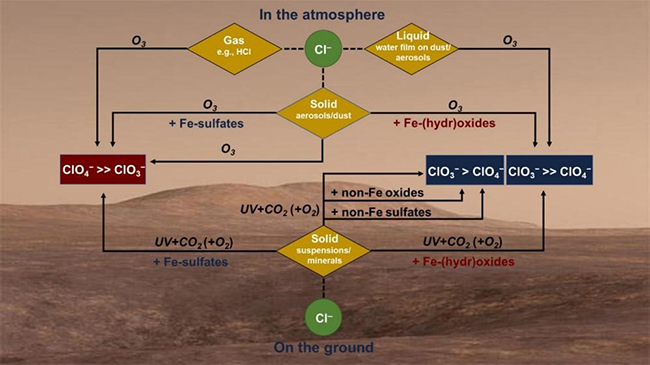Years of in situ investigation by Mars landers and rovers, plus analysis of Martian meteorites, have shown that oxychlorine species are ubiquitous on the Martian surface.
Two stable phases, perchlorate (ClO4-) and chlorate (ClO3-), are suggested in the samples where oxychlorine species are detected. However, the factors that control the ClO4-/ClO3- generation ratios are not well understood.
Recently, Dr. ZHAO Yuyan’s group from the Institute of Geochemistry of Chinese Academy of Sciences (CAS), in collaboration with Prof. WANG Junhu’s group from the Dalian Institute of Chemical Physics (DICP) of CAS, evaluated the influence of secondary iron minerals on the production of ClO4- and ClO3- on Mars.
This study was published in Nature Astronomy on Feb. 7.

The conceptual model for ClO3-/ClO4-generation ratios via UV and O3 oxidation in different surficial environments on Mars (Image by ZHAO Yuyan)
The ClO4-/ClO3- abundance ratio is critical for the redox conditions, aqueous environments, and habitability on Mars due to their different physical and chemical characteristics.
The researchers found that Fe secondary mineralogy was the dominant factor controlling the ClO4-/ClO3- generation ratio: Fe sulfates and Fe3+-montmorillonite mixed with NaCl produced much higher yields of ClO4- than of ClO3-, whereas the opposite was true for NaCl-Fe (hydr)oxide mixtures.
Mössbauer spectroscopy results indicated that akageneite decomposed under oxidative conditions when exposed to UV or ozone and formed a set of mixtures of akageneite, goethite, hematite, and an inferred Fe-(hydr)oxide phase. The released chloride would be catalyzed to form oxychlorine species dominated by chlorate by the mineral assemblage.
The study further indicated that the physical state of chloride (Cl-) and the characteristics of the co-occurring minerals had the most significant influence. In contrast, oxidation sources and atmospheric composition induced only secondary effects.
"This study highlighted ClO4-/ClO3- generation ratios in different surficial environments relevant to Mars," said Dr. ZHAO. "ClO3- rather than ClO4- should be the key focus of future oxychlorine-related studies for Mars, including the redox environment, habitability, in situ organic analysis, and in situ resource utilization on Mars."
This study was supported by Strategic Priority Program of CAS, the National Natural Science Foundation of China, Civil Aerospace Technology Pre-research Program, the International Partnership Program of CAS. (Text by ZHAO Yuyan)